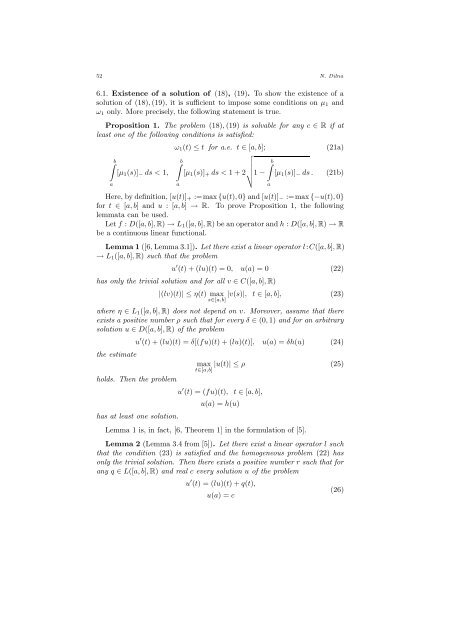ON UNIQUE SOLVABILITY OF THE INITIAL VALUE PROBLEM FOR ...
ON UNIQUE SOLVABILITY OF THE INITIAL VALUE PROBLEM FOR ...
ON UNIQUE SOLVABILITY OF THE INITIAL VALUE PROBLEM FOR ...
You also want an ePaper? Increase the reach of your titles
YUMPU automatically turns print PDFs into web optimized ePapers that Google loves.
52 N. Dilna<br />
6.1. Existence of a solution of (18), (19). To show the existence of a<br />
solution of (18), (19), it is sufficient to impose some conditions on µ 1 and<br />
ω 1 only. More precisely, the following statement is true.<br />
Proposition 1. The problem (18), (19) is solvable for any c ∈ R if at<br />
least one of the following conditions is satisfied:<br />
∫ b<br />
a<br />
[µ 1 (s)] − ds < 1,<br />
ω 1 (t) ≤ t for a.e. t ∈ [a, b];<br />
∫ b<br />
√<br />
[µ 1 (s)] + ds < 1 + 2√1 −<br />
a<br />
∫ b<br />
a<br />
(21a)<br />
[µ 1 (s)] − ds . (21b)<br />
Here, by definition, [u(t)] + :=max {u(t), 0} and [u(t)] − :=max {−u(t), 0}<br />
for t ∈ [a, b] and u : [a, b] → R. To prove Proposition 1, the following<br />
lemmata can be used.<br />
Let f : D([a, b], R) → L 1 ([a, b], R) be an operator and h : D([a, b], R) → R<br />
be a continuous linear functional.<br />
Lemma 1 ([6, Lemma 3.1]). Let there exist a linear operator l :C([a, b], R)<br />
→ L 1 ([a, b], R) such that the problem<br />
u ′ (t) + (lu)(t) = 0, u(a) = 0 (22)<br />
has only the trivial solution and for all v ∈ C([a, b], R)<br />
|(lv)(t)| ≤ η(t) max |v(s)|, t ∈ [a, b], (23)<br />
s∈[a,b]<br />
where η ∈ L 1 ([a, b], R) does not depend on v. Moreover, assume that there<br />
exists a positive number ρ such that for every δ ∈ (0, 1) and for an arbitrary<br />
solution u ∈ D([a, b], R) of the problem<br />
the estimate<br />
u ′ (t) + (lu)(t) = δ[(fu)(t) + (lu)(t)], u(a) = δh(u) (24)<br />
holds. Then the problem<br />
has at least one solution.<br />
max |u(t)| ≤ ρ (25)<br />
t∈[a,b]<br />
u ′ (t) = (fu)(t), t ∈ [a, b],<br />
u(a) = h(u)<br />
Lemma 1 is, in fact, [6, Theorem 1] in the formulation of [5].<br />
Lemma 2 (Lemma 3.4 from [5]). Let there exist a linear operator l such<br />
that the condition (23) is satisfied and the homogeneous problem (22) has<br />
only the trivial solution. Then there exists a positive number r such that for<br />
any q ∈ L([a, b], R) and real c every solution u of the problem<br />
u ′ (t) = (lu)(t) + q(t),<br />
u(a) = c<br />
(26)

















